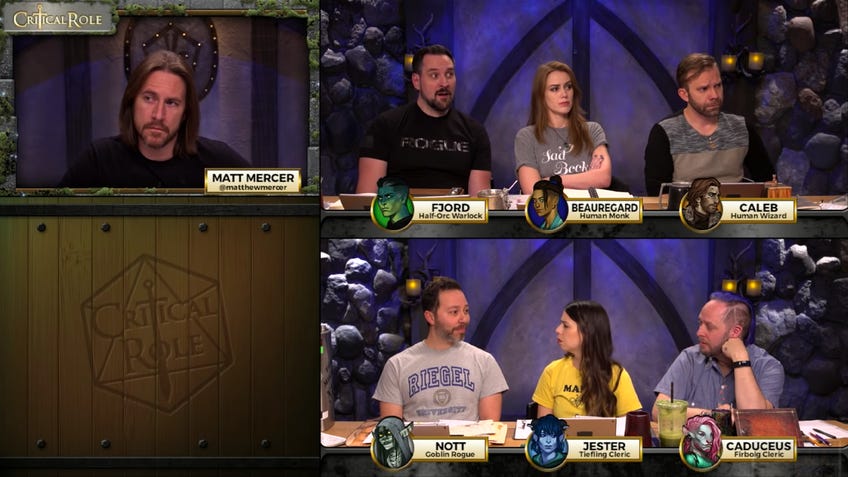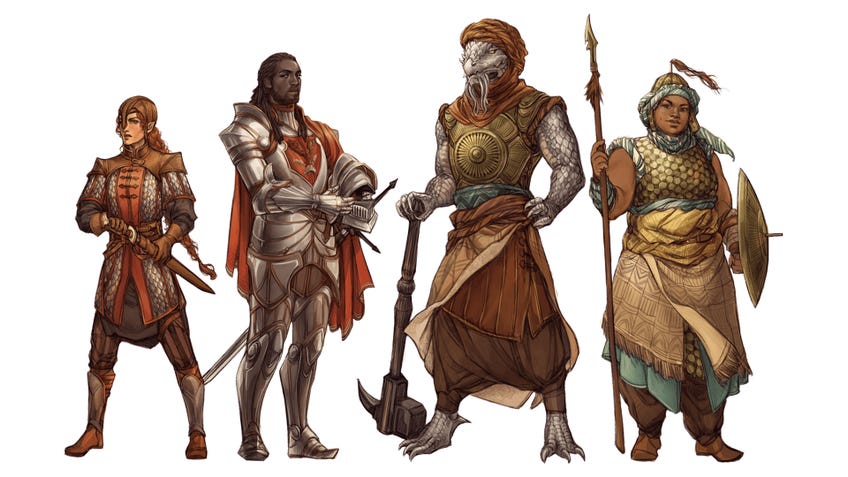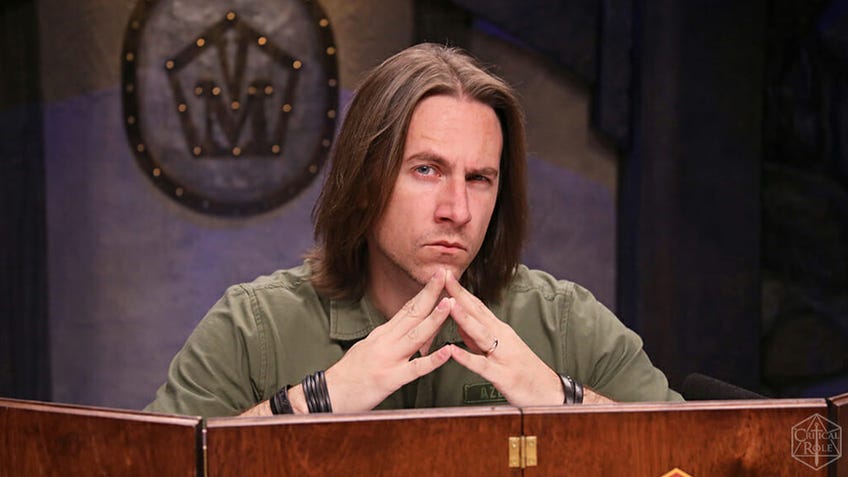Critical Role’s Matthew Mercer on world-building in D&D and creating Wildemount
Plus, whether he’d rather live in the homeland of Vox Machina or the Mighty Nein.
Beginning as a game of Dungeons & Dragons played off-camera between friends, Critical Role has since exploded into a beloved D&D actual play web series hosted by voice actor and dungeon master Matthew Mercer. With a comic book spin-off already under its belt, several Critical Role-themed board games on the way and even an animated television show in the works at Amazon, it was inevitable that Critical Role - cited by D&D maker Wizards of the Coast itself as a key element in the tabletop RPG’s fast-growing popularity - would eventually become part of official Dungeons & Dragons canon.
Released earlier this year, Explorer’s Guide to Wildemount is the first official Dungeons & Dragons 5E sourcebook based on the world of Critical Role. With Mercer at the helm as lead writer, alongside a wider team of talented writers and artists, the book is an incredibly detailed and impressive piece of Dungeons & Dragons world-building. As I found during my own time with Explorer’s Guide to Wildemount, the amount of material contained in its pages - from weird outposts in the middle of a frozen tundra to obscure gods with strange worshippers - makes the tome more than just a Critical Role encyclopedia for fans; it’s a genuinely fascinating setting for Critters and strangers to the show alike to discover.
Despite Explorer’s Guide to Wildemount having Mercer’s creative imprint all over it, the idea of capturing the world of Critical Role’s second season in an official sourcebook didn’t come from the celebrity DM.
“It was an initiation on Wizards of the Coast's end,” he says. “I would never have dreamed they'd be interested in such a thing. So when they contacted me, it was surreal as you can imagine.”
Mercer had already helped to write an unofficial sourcebook based on the setting of Critical Role’s first season, Tal'dorei. Even so - and despite the success of Critical Role - Mercer couldn’t believe that Wizards wanted his input.
“Taking all of my weird ideas [...] for my home campaign and tailoring it for a massive audience through the official lens of D&D was absolutely absurd and wonderful,” he says. “I'm still processing it!”
Mercer’s self-professed “weird ideas” serve as a lens through which a number of themes are examined in Explorer’s Guide to Wildemount, from people’s willingness to be led towards evil to the inclination of those in authority to ignore it. Among the most prominent of these is how cultures can clash when they fail to try and understand one another.
There are several examples of cultural misunderstandings throughout Wildemount’s history, one of the biggest being the continent-spanning conflict between the Dwendalian Empire and the Kryn Dynasty, which plays a major role in both the Critical Role series and Explorer’s Guide to Wildemount.
“I tend to build from a standpoint of rationalising what kinds of societies I would be interested to explore, how they'd interact or challenge one another,” Mercer observes. “I'm just extremely fascinated with culture, society, and where the joy, conflict and heroism can rise between them.”
Wildemount’s conflicting factions extend beyond the Empire and the Dynasty, with organisations such as the Cobalt Soul, an order of monks worshipping goddess of knowledge Ioun, and the ambitious royal magical advisors at the Cerberus Assembly all vying for power and knowledge. Regardless of their individual goals and aims, each of the groups outlined in Explorer’s Guide to Wildemount shares the same inability to put their differences aside and unite under a common cause - a situation that inevitably results in social and political conflict. When it comes to building worlds for Dungeons & Dragons, It’s these types of conflict that Mercer finds himself drawn to the most, becoming the foundation for many of the other aspects of his settings.
“For me, it's about setting a solid marker in the world, whether it be a faction, an event, etc. [...] and stopping to think ‘Okay, how do people react to this? What is the most logical response?’” he says.

Mercer’s world-building process begins with asking how the inhabitants of a place would respond to various points of friction. How does religious heresy affect an entire nation? What does a ruler do when their people’s traditions and way of life are threatened? These questions form the basis of Mercer’s settings, with the reactions of differing factions and individuals providing flesh around the bones. Once he feels like he’s created a satisfying enough answer - whilst still providing plenty of room for DMs and players to add their own ideas later - he moves onto the next question, with the tension between a series of dilemmas holding together a complete, coherent world.
Another key cultural conflict that Mercer finds himself inexorably drawn to is the matter of how gods directly influence a world and its people. Wildemount was formed by a group of deities known as the Creators, who made the very first races of the world and gave them the ability to shape the land as their own. When angry beings called the Primordials awoke and began raining destruction down on the people, the Creators began to feud over how to respond. Whilst some Creators chose to fight, others formed alliances with the Primordials - these gods were eventually sealed away as traitors, later returning to plague the land before being defeated once again. By the time that players step into Wildemount, the torrid history of the gods has led the Dwendalian Empire to outlaw certain faiths, whilst the Kryn Dynasty worship their own religion that focuses on rebirth and eternal life.
“I've always been a fan of mythology and pantheons of old,” Mercer says, “so the curiosity of exploring a world where there is tangible proof of divinity and the effects it can have on the world is fascinating to me.”
The curiosity of exploring a world where there is tangible proof of divinity and the effects it can have on the world is fascinating to me
The dungeon master’s fascination with faith has led to deities playing a significant part in several of Critical Role’s storylines, including an overarching plot involving a cult attempting to free the betrayer god Tharizdun opposed by the Mighty Nien and their allies. Mercer’s world is packed full of gods, ranging from the terrifying to the mischievous, all of which are detailed in an extensive section on pantheons in Explorer’s Guide to Wildemount. As for which of his own Wildemount deities he would worship, Mercer picks out the god of freedom, travel and adventure - a fitting choice for a world-builder.
“I see myself more of an Avandra, the Changebringer follower than anyone,” he says.
Alongside an interest in the mythologies of old, Mercer seems driven by a more contemporary desire to highlight humanity’s failure to learn from past mistakes.
“The ramifications of history meeting modern arrogance is a prominent theme in the world today,” he says, “and one easily explored in the middle of such a fantasy world circumstance.”
Mercer often engages with human foibles in his storytelling and world-building, particularly when they’re mixed with a dangerous cocktail of power and a lack of willingness - or ability - to prevent terrible things from happening. There are numerous examples of gifted magic users with faulty moral compasses in Explorer’s Guide to Wildemount, and it’s certainly no coincidence.

“Irresponsible magic use is a big narrative hook because it makes sense that it would be.” says Mercer.
In Mercer’s mind, magic in the world of Dungeons & Dragons always had the potential to become a terrible weapon given the right - or wrong - environment. One that Wildemount’s chaotic history, bloodsoaked land and endless conflict, whether between gods and mortals or kings and heretics, presents.
“The history of Wildemount easily made for an atmosphere where the ‘good’ mage would be a rarity by comparison.”
The consequence of mixing magic, egotism and hostility is a topic that Mercer finds himself coming back to in his worlds, as well as the ongoing effort of Critical Role’s Mighty Nein party to confront them.
I wanted Explorer's Guide to Wildemount to reflect a world ready to be used and enjoyed by anyone
“When a handful of individuals are capable of such incredible feats of destructive power and control of the world around them, the ramifications aren't just huge - they are inevitable,” Mercer says.
With Explorer's Guide to Wildemount, Dungeons & Dragons players can choose for themselves how to deal with these ramifications and which parts of the setting to explore. Despite the popularity of Nott the Brave, Caleb Widogast, Jester Lavorre, Fjord, Yasha, Caduceus Clay and Beau, Mercer decided to keep direct references to Critical Role and its characters to a minimum, allowing Wildemount to stand alone as an engaging setting.
“I chose to hold back on too many direct references [to Critical Role],” he says. “Fans of the show will know the characters and stories well enough to incorporate whatever elements they wish [...] but I also wanted this book to reflect a world ready to be used and enjoyed by anyone.”

Mercer’s commitment to creating an authentic D&D 5E sourcebook - rather than a celebration of Critical Role - means that Explorer’s Guide to Wildemount is a useful tool for experienced players wanting to make their own Dungeons & Dragons campaign regardless of their interest in Critical Role, whilst still providing fans of the show with the opportunity to lose themselves in Mercer’s world.
“I wanted GMs and players to feel like they got to create their own story in Wildemount, without feeling shackled to the existing narrative we [Critical Role] are still playing through,” he explains.
Even so, Mercer couldn’t quite resist dropping a few specific Easter eggs into the book’s pages for readers and fans to discover.
“My favourite Easter egg deals with a hidden monolith near the Aeor crash site in Eiselcross” he teases. “Not an Easter egg for Critical Role, per se, but an Easter egg for 5E D&D in general.”
Though Critical Role began as a private game much like any other (the star power of its players aside), becoming dungeon master for a Dungeons & Dragons campaign watched by thousands - many of whom study it in intense detail for fan-made artwork, fiction and more - has undoubtedly changed Mercer’s approach to world-building.
“It's easier to get away with silly plot holes or fuzzy narrative bits when you are just building it for your players at the table,” he explains, “but when you have hundreds of thousands... millions of people pulling at the loose threads of your world week after week? You begin to wrack your brain more often to try and build a stronger, more solid foundation.”
The success of Critical Role and the demands of opening his world up to more than just the players around his table has forced Mercer to become more than just “the man behind the curtain flailing”, as he puts it.

Despite his world’s enshrinement in Dungeons & Dragons lore in the form of Explorer’s Guide to Wildemount, the thousands of fans eager to learn more about it week after week and his arguable place as the DM of the moment, Mercer remains dumbstruck by the reaction to his creation.
“I'm still surprised people enjoy what I do!”



